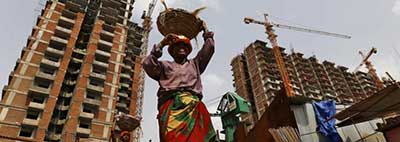Relevance: GS-3: Indian Economy and issues relating to planning, mobilization, of resources, growth, development and employment.
Key Phrases: Formalisation, Fiscal concession, Capital investment, Digitalisation, Dwarfism, Social Security, Open and disguised unemployment, Structural transformation, Subcontracting and outsourcing, Demographic transition.
Why in News?
- Policy efforts to formalise the economy in the recent past have produced limited results as the bulk of informal units are petty producers. With the onset of Covid-19 pandemic, the status of the Indian economy needs to be analyzed with growing digitization in every field.
Background:
- Since 2016, the Government has made several efforts to formalise the economy. Currency demonetisation, introduction of the Goods and Services Tax (GST), digitalisation of financial transactions and enrolment of informal sector workers on numerous government Internet portals are all meant to encourage the formalisation of the economy.
Present status of Informalisation in India:
- As per official data, 90% of workers in India have remained informally employed, producing about half of GDP.
- As per ILO (International Labor Organization) and India’s official definition, the share of formal workers in India stood at 9.7% (47.5 million).
- Official PLFS data shows that 75% of informal workers are self-employed and casual wage workers with average earnings lower than regular salaried workers.
- About half of informal workers are engaged in non-agriculture sectors which spread across urban and rural areas
It is understood that the ability of firms to avoid minimum wage laws, certain types of taxes and the livelihood needs for a vast majority of population leads to the formation of the informalized sector in developing countries like India.
Reasons for Informalization in India:
- Historical: Tax reforms initiated in the mid1980s. Early on, in
an attempt to promote employment, India protected small enterprises engaged
in labour intensive manufacturing by providing them with fiscal concessions
and regulating large scale industry by licensing.
- This led to rise of many labour intensive industries getting diffused into the informal/unorganised sectors
- Government Policy: Interlinkages between the informal and formal sectors via subcontracting and outsourcing arrangements for labor in the labor abundant South Asian market.
- As per Economic Survey - Dwarfism (smaller firms, employing less than 100 workers) dominate the Indian economy, these never grow beyond their small size in order to get tax benefits and incentives, and hold back job creation and productivity.
Financial institutes like the IMF (International Monetary Fund), argue that excessive regulation and taxation ensure the endurance of informal activities.
Why the impetus for formalisation?
- The formal sector is more productive than the informal sector, it has better human resources with skill and training and has higher efficiency.
- Formal workers have access to social security benefits. It helps in the inclusive growth of the Indian economy and provides protection to the worker in the era of exploitative capitalism.
- Widening the tax net and reducing tax evasion are necessary for increasing government revenue especially to boost the economy in the post pandemic era.

- Informal economy manifesting itself most visibly in urban squalor, poverty and (open and disguised) unemployment is a hindrance to sustainable development plan of India.
- Low wages in the informal economy lead to a low savings rate, which is detrimental for the credit cycle and further lending, hampering development, thus it creates a vicious cycle.
A well regarded study, ‘Informality and Development’ argues that the persistence of informality is, in fact, a sign of underdevelopment. Therefore informality is now differentiated and multilayered. The defining characteristic of economic development is a movement of low productivity informal (traditional) sector workers to the formal or modern (or organised) sector — known as structural transformation.
Way ahead
- Simplifying registration processes, easing rules for business conduct, and lowering the standards of protection of formal sector workers will bring informal enterprises and their workers into the fold of formality.
- A sustained structural transformation is required with holistic development of the informal sector by alleviating legal and regulatory hurdles and providing necessary infrastructure to small firms.
The economy will get formalised when informal enterprises become more productive through greater capital investment and increased education and skills are imparted to its workers. A mere registration under numerous official portals will not ensure access to social security, considering the poor record of implementation of labour laws.
With India at the cusp of a demographic transition and adding a million workers to its workforce every month, there is a dire need to create formal sector jobs. Also, increased informalisation is detrimental as it impacts the long term goals. So we need to shift towards inclusive growth via a formal economy.
Source: The Hindu
Mains Question:
Q. Informalisation has remained a challenge to the Indian economy. Discuss what are the challenges and why India needs to push for formalization with its growing effort on digitization. [250 words]







